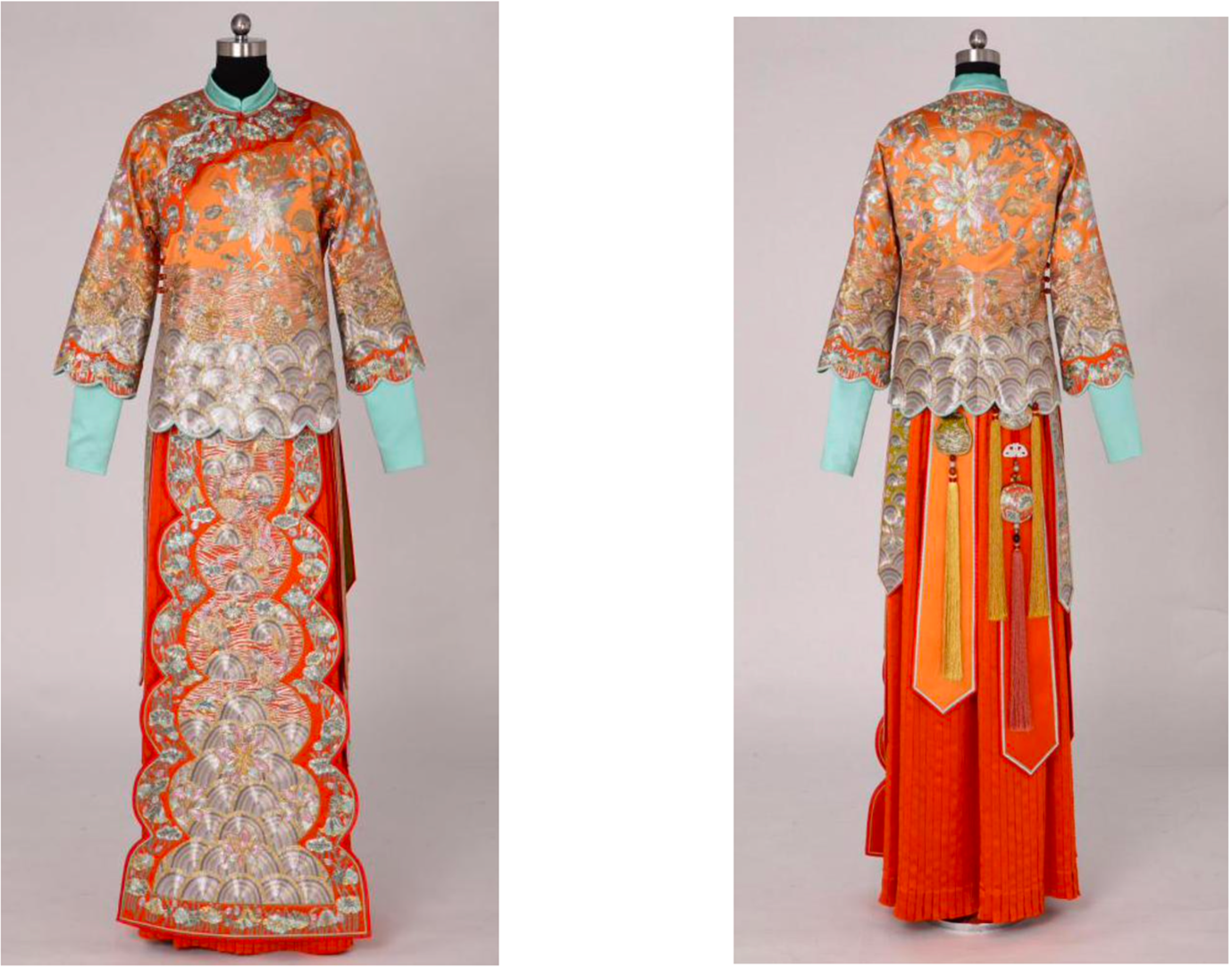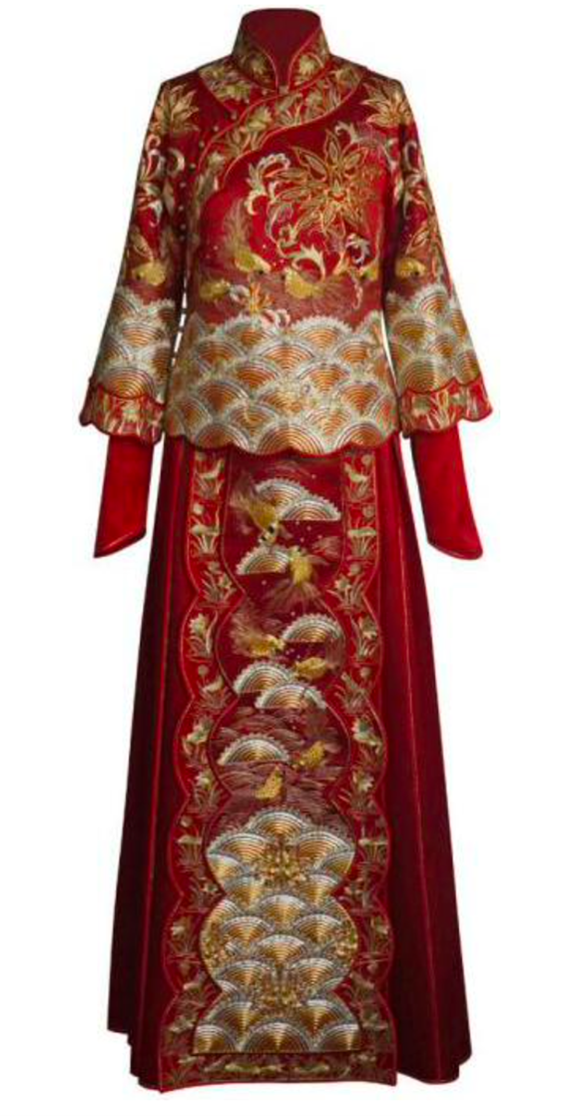Judicial Developments in Copyright Protection for the Fashion Design Industry in China: Clothing Pattern Combinations and Their Presentations on Garments May Be Eligible for Copyright Protection
25 Apr 2025 | Newsletter
- Works Claimed by the Plaintiff

- Infringed Garment

1.Case brief
Plaintiff Beijing Rose Studio Fashion Custom Co., Ltd.’s core designer Guo Pei is China’s first haute couture fashion designer and remains Asia’s only and China’s sole invited member of the Chambre Syndicale de la Haute Couture de Paris to date. Guo Pei has provided haute couture services for key hosts and leading performers’ costumes in CCTV’s Spring Festival Gala for consecutive years and also designed the medal presentation uniforms for the 2008 Beijing Olympics, enjoying significant renown in the haute couture industry.
The involved garment “Little Goldfish Orange Bride Guaqun” designed under Guo Pei’s leadership creatively combines traditional Chinese costume elements with pattern compositions, incorporating guaqun-specific tailoring techniques to present an original aesthetic design (hereinafter “the Involved Works”). Upon their creation, the Plaintiff completed copyright registrations for these works.
First Defendant Beijing A Fashion Store is an individual business operator registered in Chaoyang District, Beijing, specializing in high-end custom garment production and sales. The Plaintiff discovered that the First Defendant sold custom-made garments highly similar to the Involved Works through its Taobao storefront and offline boutiques. Second Defendant Beijing B Company, an affiliated entity of the First Defendant, promoted the accused garments on social media platforms including its operated Sina Weibo and provided direct hyperlinks to the First Defendant’s Taobao store.
The Plaintiff alleged that both Defendants committed copyright infringement of the Involved Works. Both the trial court and appellate court rendered judgments holding the Defendants jointly liable for infringement and ordered them to pay damages.
2.Exemplary Significance
In this case, the works claimed by the Plaintiff can be divided into two components: one is the pattern element combination on the ready-to-wear garments, and the other is the morphological presentation of these pattern elements on the clothing. Although the pattern elements include common Chinese traditional costume motifs such as goldfish, water ripples, and flowers, the specific forms, quantities, sizes, arrangements, and combinations of these elements reflect the creator’s original expression, thus qualifying as artistic works under the Copyright Law.
Regarding whether ready-to-wear garments can constitute works under copyright law, the appellate court held that the analysis must be based on the specific circumstances of each garment. Generally, clothing is classified as a useful article, and fashion design is premised on functional utility. The prerequisite for a garment to obtain copyright protection is that its utility and aesthetic value are conceptually separable. If the artistic design of clothing merely serves its practical function, it cannot be deemed a copyrightable work. The garments claimed by the Plaintiff, namely the guaqun (bridal 褂裙), are special types of useful articles where aesthetic value far exceeds functional utility beyond basic warmth and coverage. In this case, the combination of patterns and tailoring on the Plaintiff’s claimed guaqun enhances the wearer’s figure and demeanor, endowing the design with distinct aesthetic appeal that reflects the designer’s creative labor. This aesthetic value can be conceptually separated from the guaqun’s practical functions, qualifying it as an artistic work protected by copyright law.
The First Defendant further argued that differences in embroidery techniques between the Plaintiff’s physical garments and the Defendant’s accused products negated copyright infringement. The appellate court ruled that specific embroidery techniques are not subject to copyright protection. Even if techniques differ, substantial similarity in the final expressive form of the works still constitutes copyright infringement.
3.Conclusion
In the fashion industry, plagiarism remains a chronic ailment. For original designers, the difficulty of enforcing intellectual property rights manifests not only in the costs of initiating legal proceedings but also in establishing a solid rights foundation. Clothing is generally recognized as a “work of applied art” integrating artistic and functional elements. However, because fashion design is embedded within the garment as an indivisible whole, the indistinguishability of artistic and functional aspects often precludes standalone protection for the artistic components. The innovation of this case lies in its recognition that two components could individually qualify as copyrightable works: the pattern element combination and its morphological presentation on the ready-to-wear garment, thereby charting a new course for IP enforcement in the fashion sector.
The first-instance and appellate judgments were rendered by the Beijing Chaoyang District People’s Court and Beijing Intellectual Property Court—courts celebrated for their excellence in intellectual property adjudication. By reaching unanimous conclusions on infringement through rigorous reasoning, the publicity of this case provides confidence to fashion industry practitioners in enforcing their rights while offering a practical example of how to protect creative outputs through intellectual property mechanisms.
